Do I Need a Dutch Oven to Make Mozzarella Cheese
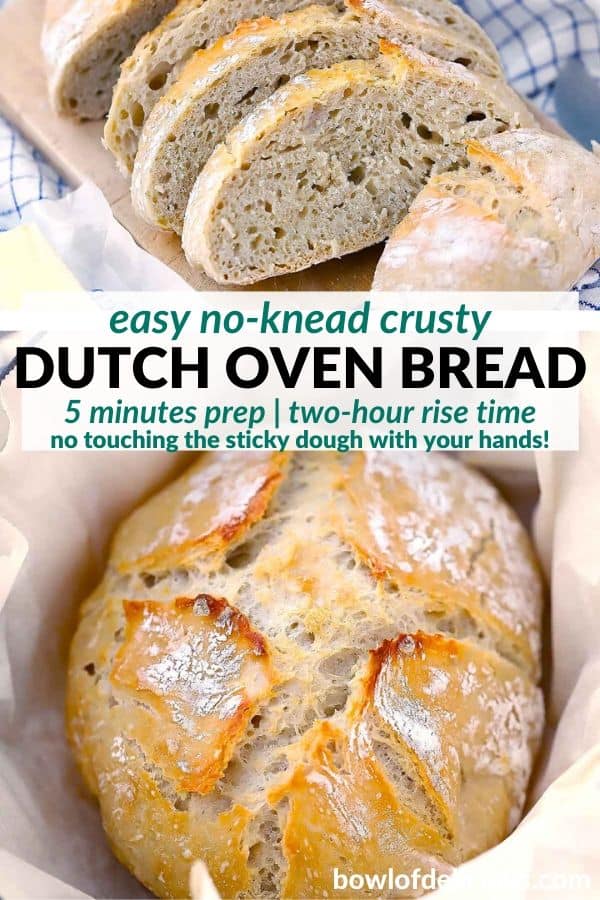
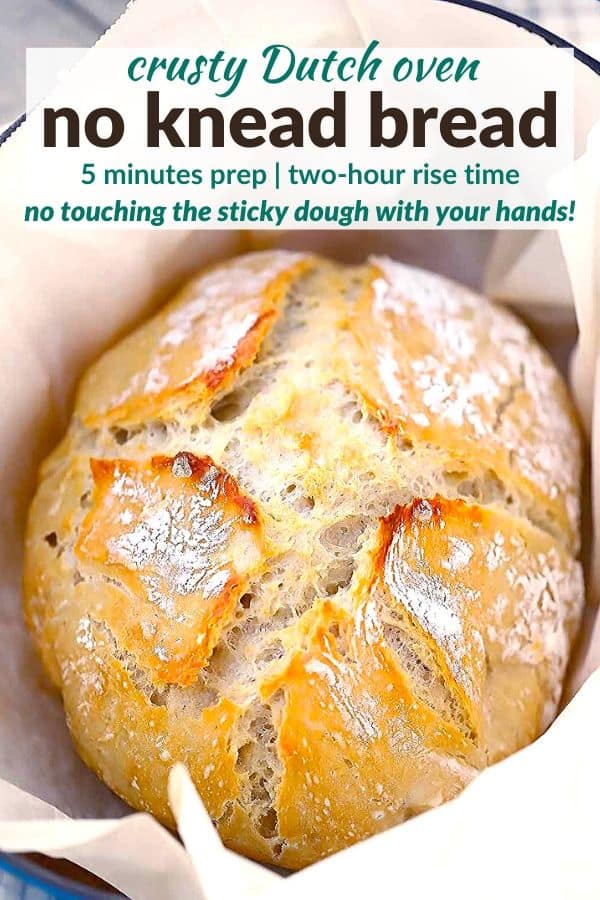
This Dutch Oven No Knead Bread is the perfect way to make a delicious, crusty artisan loaf in the comfort of your own home! Best of all? It takes only FIVE MINUTES of prep, and you don't have to ever touch the sticky dough with your hands! With a short, two-hour total rise time, you can make this for dinner tonight.
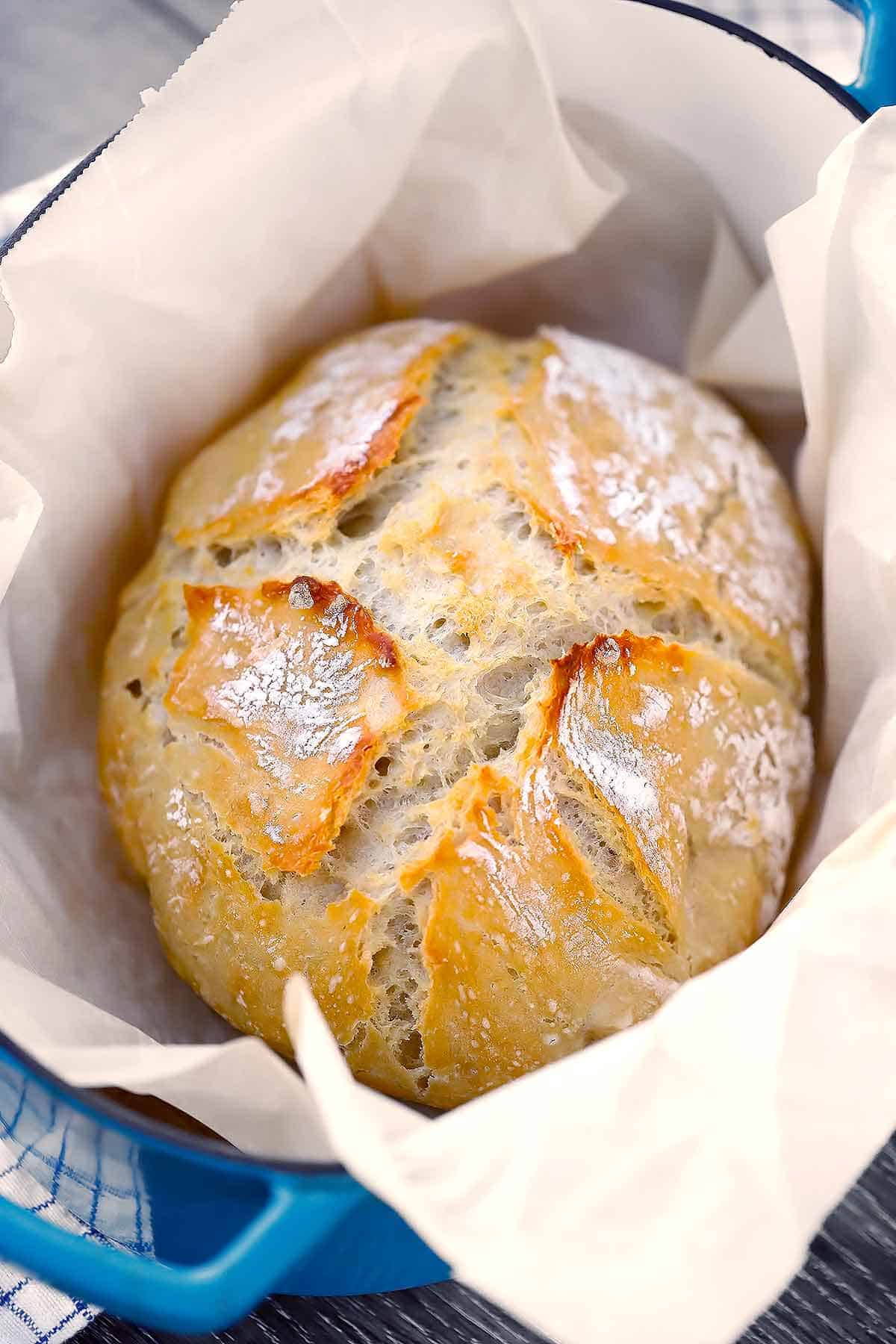
I'm a good cook. I mean, I'm allowed to brag about that… I've built a career out of it with this website. But until know, I've had the HARDEST time making a good homemade bread.
Am I alone in this? Homemade bread has always eluded me and been a real challenge. My homemade breads have always been too flat, too dry, too hard, too annoying and sticky to work with, etc.
UNTIL NOW.
YOU GUYS. I finally cracked the code for homemade bread that isn't a hassle and is so amazingly delicious, moist, with fluffy holes, and with the perfect crusty crust!
You can use all-purpose flour – no need for fancy bread flour!
This is the only no knead bread recipe you'll need, and it's great for beginner bread bakers. The Dutch oven is key for developing a perfect crusty crust and keeping the inside perfectly moist, and best of all, you don't EVER have to touch the super sticky dough with your hands!
You can let this dough rise for only 2 hours and bake it right away, OR you can keep the dough in your fridge for up to 7 days and use when you want to. Unlike other no-knead bread recipes that require 12 hours minimum rise time.
Here are all the details.
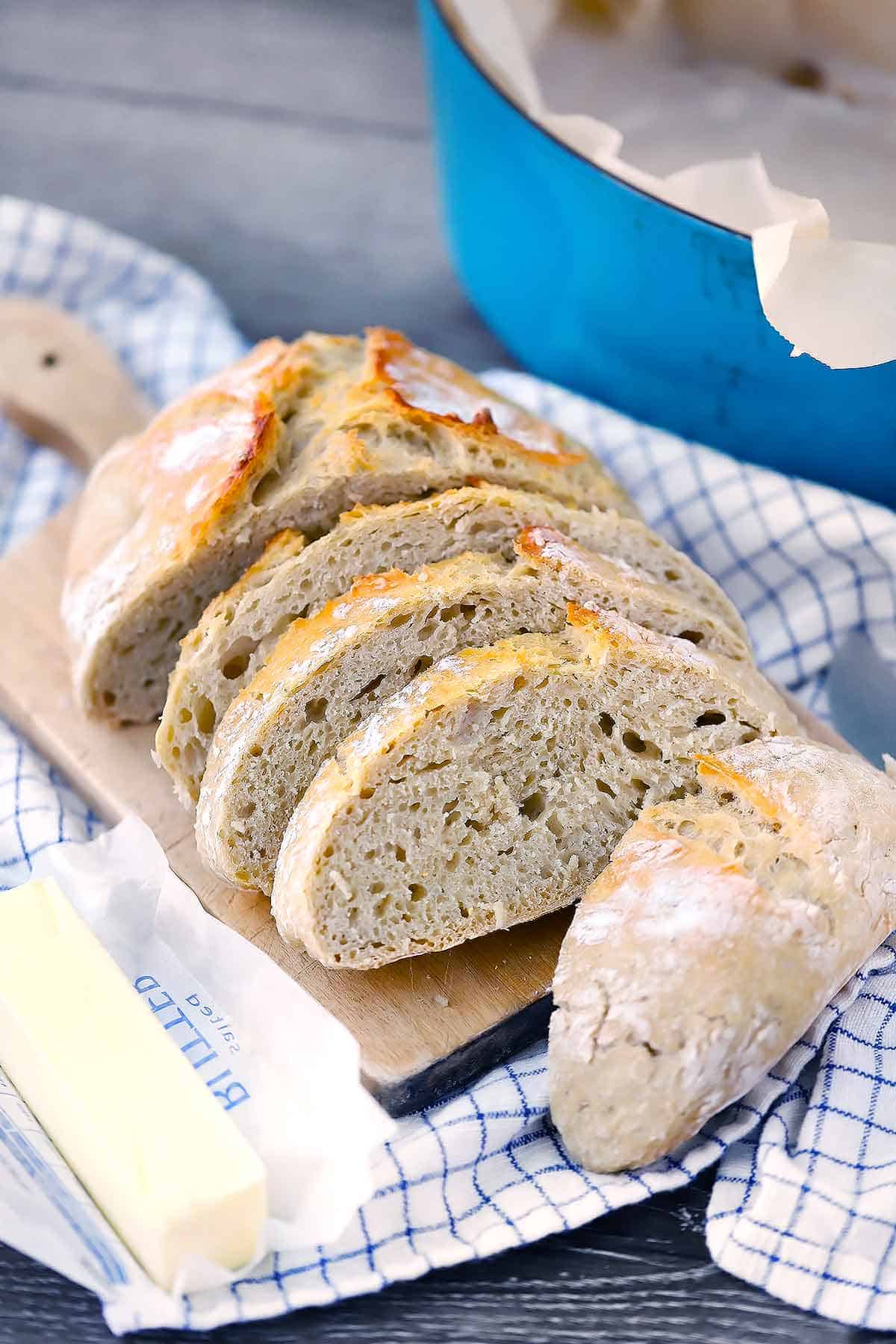
First of all, what is no knead bread?
No knead bread is, as the name suggests, bread that can be made without kneading the dough. No need to knead. Hah!
The dough is notoriously very loose and sticky, which can make it a little frustrating to work with(which is why I developed this method to not touch it at all- it takes a lot of that frustration away!).
No knead bread loafs do not need a second rise time, like a traditional loaf. The bread doesn't have enough structure to rise "up," and instead will flatten out and fill the shape of whatever you are making (Note: you CAN do a second rise time with no knead focaccia, which is a flatter bread type.)
The lack of a second rise results in two things: first, a faster overall time to make. And the second: it won't have as many holes as a kneaded bread dough.
While I love a good fluffy artisan bread with holes for days, I think the pros here outweigh the cons. The bread DOES have some good holes, it's got a great texture, and the fact that it's so easy and hassle free is enough to make me never want to make a kneaded artisan loaf again!
How to make no knead dough
You only need water, yeast, flour, and salt for this no knead bread dough.
- First, warm the water (1.5 cups) to about 100 degrees F. A little more or less is fine. I usually measure it in my pyrex measuring cup and put it in the microwave for about 40 seconds, then take the temperature with a meat thermometer to make sure it's the right temp. Don't go any hotter than 110 degrees F – it might kill the yeast.
- Then, add the warm water to a large bowl, along with a packet of yeast, or 2.25 teaspoons (instant or active dry is fine) and 1/2 tablespoon of table salt(or 2 teaspoons kosher salt). Whisk together until the yeast and salt are dissolved.
- Finally, add the flour – 3.25 cups – all at once, and stir with a wooden spoon until everything is uniformly wet.
I like to use a silicone spatula to scrape the dough off the wooden spoon, as it will be quite sticky and loose.
Letting the dough rise
Once the dough is mixed, just cover it with a kitchen towel and let it rise in a warm-ish spot for two or three hours. It should double in size at least.
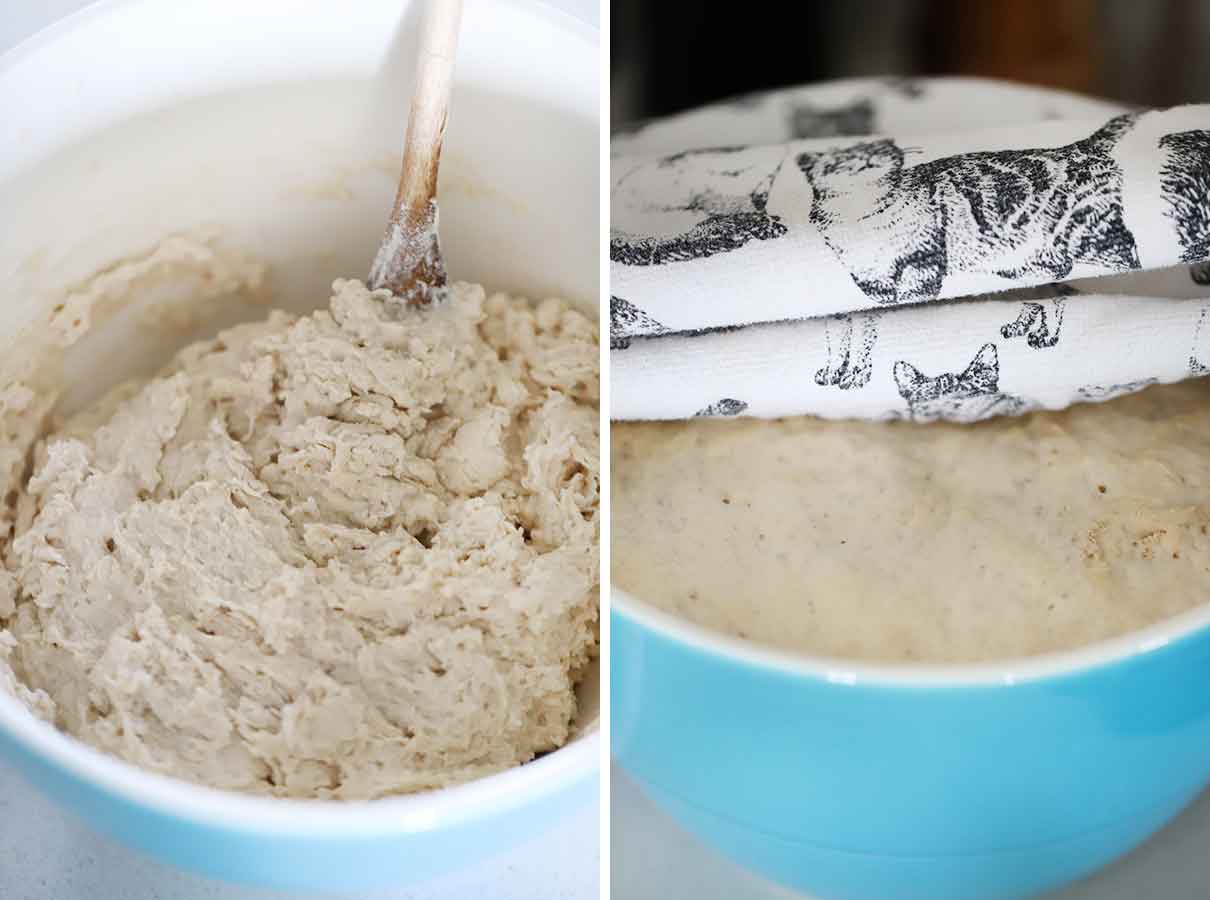
If your house is cold, I recommend turning your oven on for a few seconds, turning it off, and placing the bowl in the warm oven with the door closed to trap the heat in.
If you're using your oven to cook something(or in the next step when you need to preheat your Dutch oven), you can leave the bowl on top of the stove- the vented heat at the top will help it rise well.
You can also get some really hot water in a mug or glass measuring cup, stick it in the microwave, and place the bowl next to it. Shut the door to the microwave- this will trap the warmth and steam inside.
If your house is warm,you can just leave it out.
If it's warm outside, you can leave the bowl outside.
Storing the dough in your fridge
After the dough has risen for 2 hours, you can bake it immediately. But if you like, you can stick it in your refrigerator for up to 7 days until you're ready to bake it!
Cold dough is a little easier to handle, so that's a pro for this.
Keep the kitchen towel on the bowl in the fridge for two days. After two days, you can use plastic wrap or something more airtight to cover the bowl. If you know you are making this dough days in advance, you can mix it up in a container, keep the lid on ajar while it's rising and for the first two days, and seal the lid after the second day.
The taste will get funkier as time goes on- by the 7th day, the bread will taste more like sourdough. And the dough will collapse over time- don't worry about this.
Preheating the Dutch Oven
You want your Dutch oven to be good and hot for baking the bread so it gets a chance to crisp up properly on the outside.
About 30 minutes to an hour before you want to bake the bread, place the Dutch Oven, with the lid on, on the center rack of your oven and turn your oven on to 450 degrees F. Once it reaches 450, keep preheating the Dutch Oven for about 20 minutes.
Be very careful when handling the hot Dutch oven, as it's very heavy and gets searing hot.
Forming the loaf
Here's my favorite part! This is how to make the sticky mess of a dough into a loaf without having to touch it with your hands.
- First, lay a piece of parchment paper on your counter and sprinkle some flour on the bottom part closest to you.
- Then, use a silicone spatula to scrape the dough in a pile onto the floured part. Try to be gentle. The more you handle the dough, the more gasses escape, and the fewer fluffy holes there will be in the loaf.
- Use the silicone spatula to form it into a "loaf" shape, scooping up the dough from the bottom of the pile and placing it on top. You don't need to do much of this- you just want it to be less of a "pile" and more of a "loaf." You may also want to make it circular or oval shaped, depending on what shape your Dutch oven is.
- Finally, grab the corners of the parchment paper closest to you and use them to gently flip the loaf onto the center of the sheet of parchment. It may be a little misshapen, which is fine. If it bothers you, you can use the spatula to try to shape it some more but keep in mind, the more you handle it, the less fluffy the loaf will be.
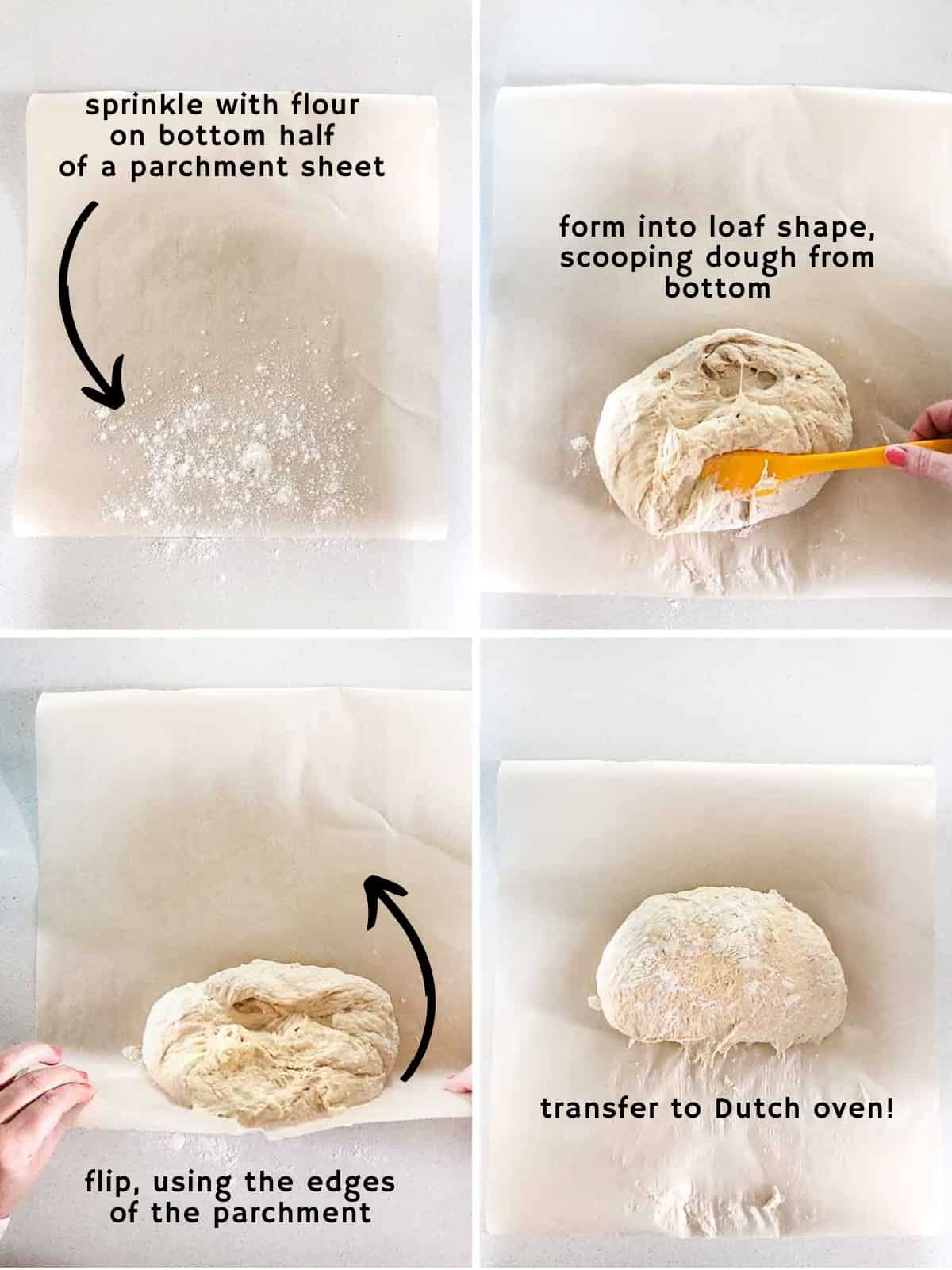
At this point, before putting it in the Dutch oven, you can use a very sharp knife or clean razor blade to make a few cuts about 1/2″ deep in the top of the loaf. I did this with mine in a cross shape from end to end in both directions. This will help it rise up a little more in the oven and get some browner crustier bits. But it's totally optional.
Baking the bread
Once you have the loaf shape in the center of your parchment, open your oven door and take the lid off the Dutch oven(USING POTHOLDERS of course).
Then, grab the sides of the parchment paper and transfer the loaf to the Dutch oven. Place the cover BACK ON (USING POTHOLDERS FOR THE LOVE OF GOD), and bake at 450 degrees for about 35 minutes.
I know I keep yelling about potholders but too often I've reached absentmindedly for the lid of a Dutch oven thinking it's going to be cool but it's searing hot. It's easy to make that mistake!
Once the 35 minutes are up, take the lid OFF, and bake for another 5-10 minutes, until it's golden brown.
Stop for a moment, and inhale deeply. The smell of fresh-baked bread is one of the best things in the world.
Finally, remove the bread by holding the parchment paper, and place on a wire rack or a cutting board to cool. You want it to cool for at least 10 minutes before slicing.
AND YOU'RE DONE! Congrats on your gorgeous artisan Dutch oven bread!
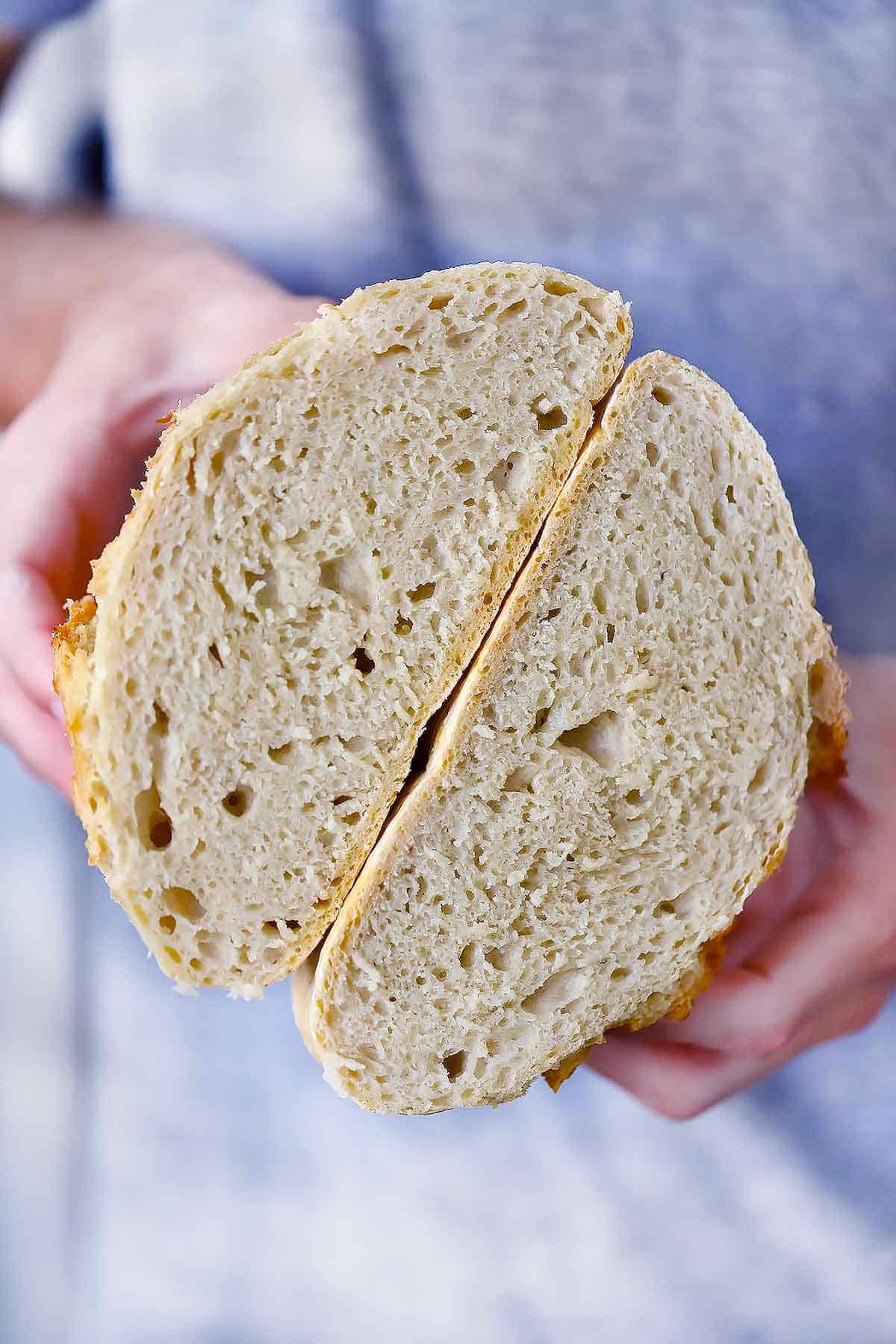
Why does the lid to the Dutch Oven need to be on while it bakes?
The key to moist bread with a perfectly crusty crust is that it needs to be baked in a humid environment. I know it seams counter-intuitive, but it really works.
The lid to the Dutch oven traps the steam from the sticky dough inside, making it a perfect bread baking environment.
Then, taking the lid off for the last bit of cooking helps really brown the top of the loaf without it over-drying.
It's truly a miracle to behold. And it's why we can call it "artisan bread!"
But what if I don't have a Dutch Oven?
Glad you asked.
This bread is possible to make without a Dutch oven, but you won't get the same amazingly crusty results. Don't let that stop you- just temper your expectations a bit.
You can bake the bread, on parchment paper since the dough is so sticky, on a baking sheet or, preferably, in a preheated cast iron skillet.
Here's what you can do to help make it extra tasty with a crusty crust.
Create a humid environment in your oven by placing a rimmed baking sheet on the bottom rack while the oven preheats. When you add the bread to the oven, pour about 4 cups of water onto the preheated baking sheet. This will create steam as the cold water hits the hot metal. Close the oven door as fast as you can to trap the steam inside.
Can I use another kind of flour?
I used all-purpose for this crusty artisan bread, but you can use bread flour if you like.
You can also use part whole wheat flour– I recommend substituting 1 cup of the AP flour with whole wheat. A 100% whole wheat loaf has not been tested, but it might work.
I haven't tried using a gluten-free flour mix for this and therefore cannot recommend it. Here's a gluten-free artisan bread that might be helpful for you!
And finally, you should never substitute a non-flour flour, such as almond flour or chickpea flour, for AP flour. Those won't work with this bread.
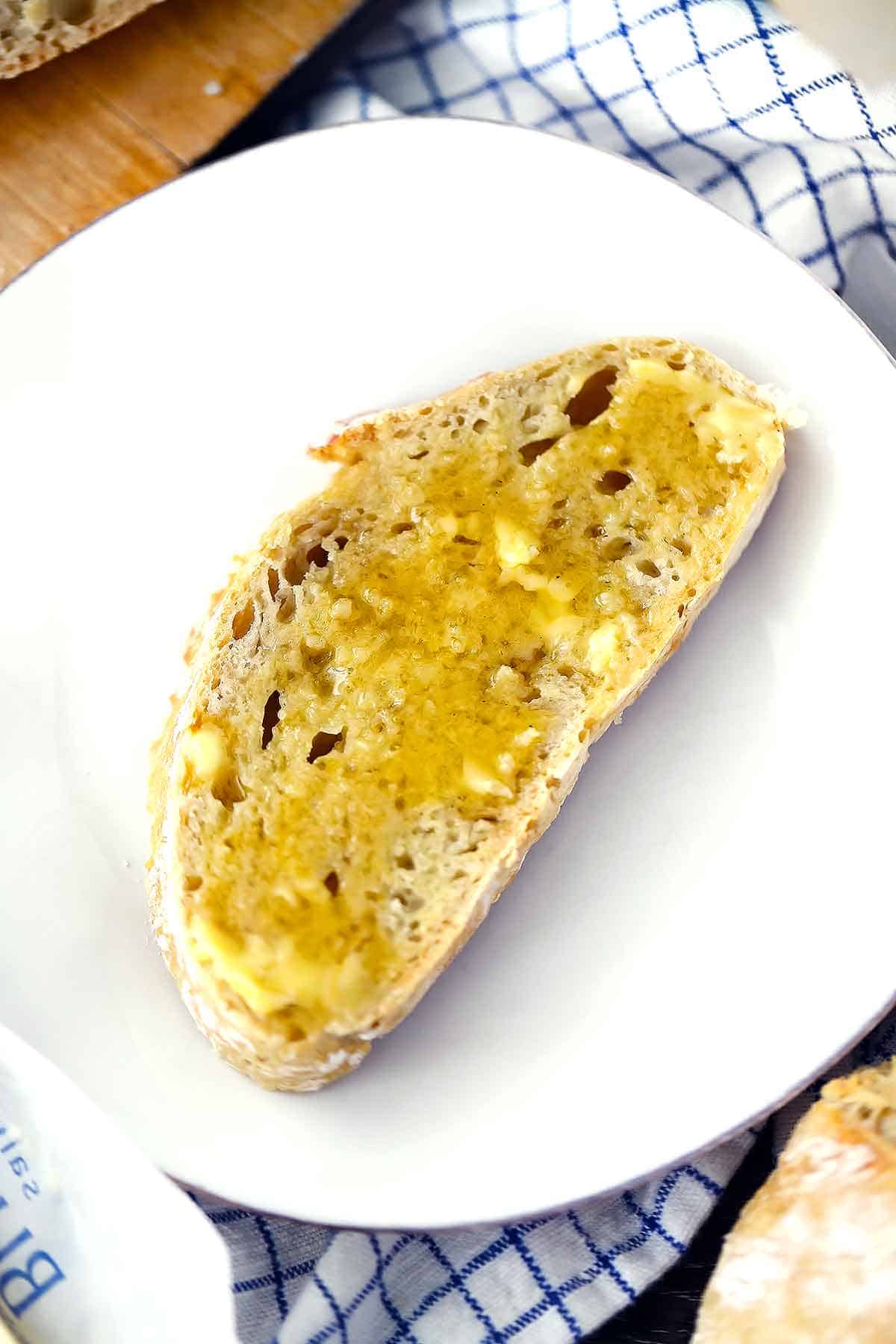
Can I freeze it?
Yes!
The bread stays good at room temperature in a plastic bag or airtight container for about 2 days, and it will get staler as time goes on. Any longer than 1-2 days, and you should freeze it.
You can freeze the loaf whole if you like- you'll just need to leave it out for about 12 hours before you can slice into it.
Or, you can slice it before freezing, which enables you to take out one slice at a time for toast or sandwiches.
Here are some tips for freezing:
- Store the whole loaf or sliced loaf in an airtight bag, squeezing out as much air as possible. This will help prevent freezer burn.
- Wait until it's COMPLETELY cool before storing, especially if you're slicing it before, as the slices may stick together if you don't.
It should stay good for 2-3 months in the freezer if stored properly.
How to serve an artisan bread loaf
I'm a big fan of eating the bread smeared with salted butter and drizzled with honey, as pictured above. But this homemade bread would be delicious…
- Served with a hearty soup, like split pea soup or lentil soup.
- Used for a fancy grilled cheese, like this leek and gruyere grilled cheese.
- To make cold sandwiches, like this fresh mozzarella, tomato, and basil sandwich with balsamic glaze.
- Served sliced with a basic olive oil and balsamic bread dip, as a side to your favorite Italian pasta recipe(like this five-ingredient pasta with Bolognese sauce).
- Used to sop up the sauce from classic shrimp scampi.
What to make with the stale bread
If you forget about the bread and leave it out at room temperature for more than a couple days, it may go stale. I hardly ever have this happen, as my family and I inhale the entire loaf in one sitting usually. But there are a few things you can do with the leftover stale bread!
Here are my favorites:
- Make homemade croutons with it
- Use it in Panzanella salad
- Make a Tuscan Tomato and Bread soup
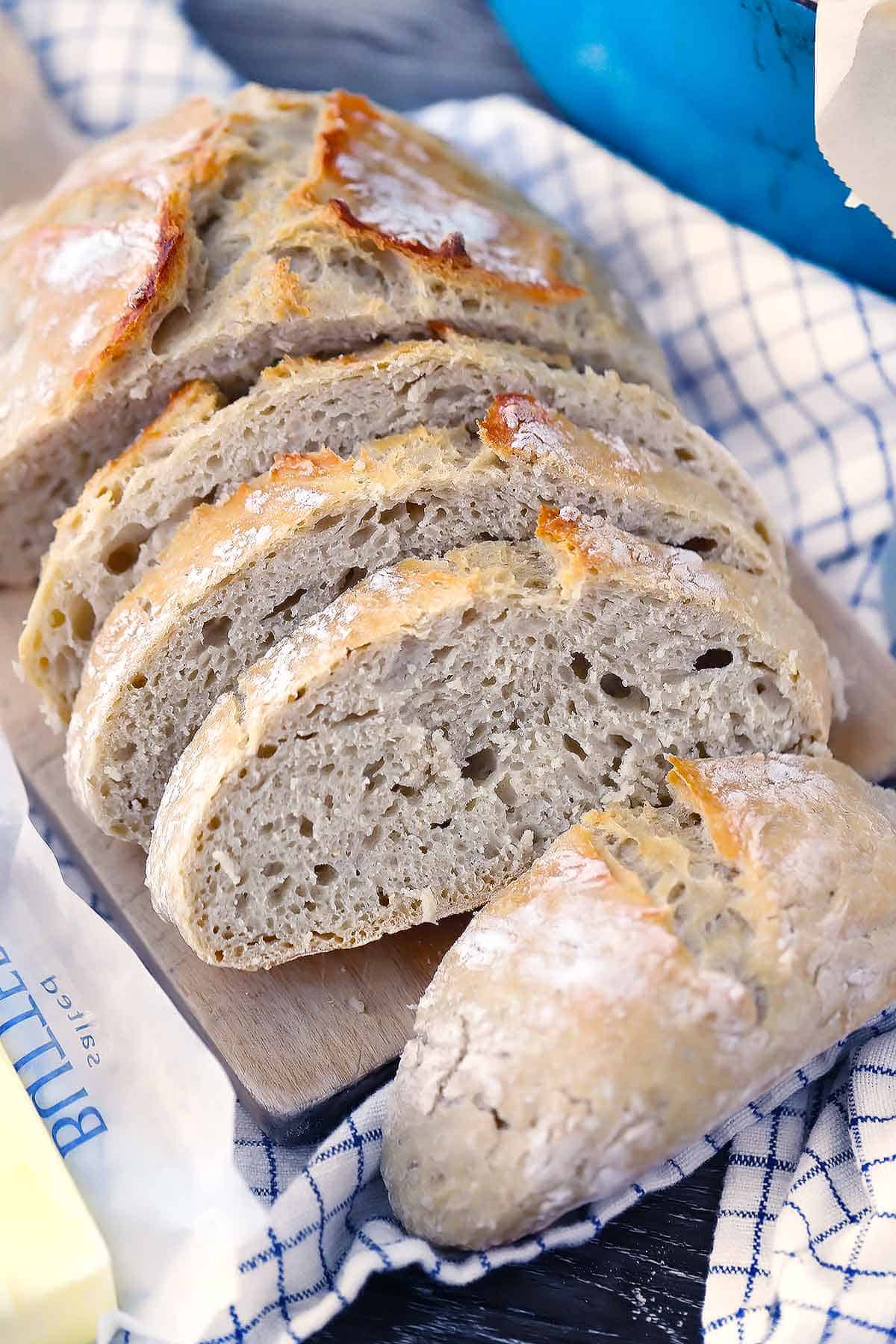
Other easy yeast bread recipes
- Quick and Easy Dinner Rolls
- Vasilopita(Sweet Greek New Year's Bread)
- Whole Wheat No-Knead Focaccia with Rosemary and Sea Salt
- Honey Whole Wheat Pizza Dough
- White Sandwich Bread(from The Brown Eyed Baker)
Check out all my homemade basic essential recipes here.
I also LOVE using my Dutch oven to roast a whole chicken.
Did you know commenting and rating recipes is one of the best ways you can support your favorite food bloggers? If you made this Dutch Oven No Knead Artisan Bread, please click the stars below to comment and Rate this Recipe
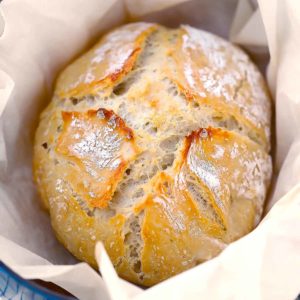
-
Silicone Spatula
-
Parchment Paper
- 1 1/2 cups warm water (about 100 degrees F)
- 1 packet yeast (active dry, instant, or quick rise- 2.25 teaspoons)
- 1/2 tablespoon fine grain salt (see notes)
- 3 1/4 cups all-purpose flour or bread flour, plus more for dusting
-
In a large bowl (or container), mix together the warm water (1.5 cups), yeast (1 packet/2.25 teaspoons), and table salt (1/2 tablespoon), until yeast and salt are fully or almost dissolved (I like using a whisk for this).
-
Add the flour (3.25 cups) to the bowl all at once and stir together until a sticky dough forms. Don't worry about mixing it too much, just make sure everything is uniformly wet. It WILL be messy and sticky. You can scrape what's left on the spoon with a silicone spatula.
-
Cover the bowl with a kitchen towel (or place the container to the lid on ajar). Leave it for 2-3 hours to rise in a somewhat warm place (If it's cold out, I like to preheat my oven for a few minutes, then turn it off, then place the bowl in the oven, trapping the heat inside. If your house is warm just leave it out, or if it's warm outside you can place it there).
-
After the two-three hour rise time, you have two options: bake, or store in the fridge. See notes for how to store.
-
30 minutes to an hour before you are ready to bake, preheat your oven to 450 degrees F. Place your Dutch oven in the oven, with the lid ON, while the oven is preheating. Once the oven reaches 450, keep it preheating for another 20 minutes, so the Dutch oven gets good and hot.
-
Scrape the dough into the edge of a piece of parchment paper dusted with flour. Make it into as much of a "loaf" shape as you can by folding the edges up on top of it (a silicone spatula works well for this).
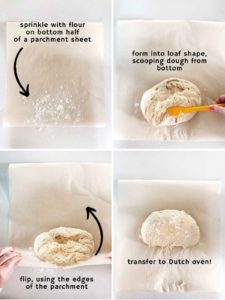
-
Then, use the edges of the parchment paper to flip the loaf over so the floured side is on top and the loaf is in the center of the parchment paper. Don't worry about it looking beautiful or smooth on top. My Dutch oven is an oval, so I made an oval shape. You can do a circle if yours is round.
-
Optional: use a very sharp knife or clean razor blade to cut a few slits across the top of the loaf about 1/2" deep, across the entire top. I did this in a cross shape for mine.
-
Take out the preheated Dutch oven and take off the lid, carefully! Grab the parchment from the sides and place the loaf in your Dutch oven.
-
Place the cover back on the Dutch oven and place in the preheated oven on the center rack. Bake for 35 minutes at 450 degrees F (40 minutes if dough was cold from the fridge). Remove the lid and bake for another 5-10 minutes, until a golden brown color forms- longer if necessary. Remove the loaf from the dutch oven (grabbing the sides of the parchment paper works well here) and place it on a wire rack or cutting board to cool for at least 10 minutes (preferably 30 minutes - an hour, if you have time) before slicing.
- Make two small loaves instead: This recipe makes about a 2 lb. loaf. You can make two smaller, 1 lb. loaves, by using only half the dough at a time, saving some in the fridge for later. Alternatively, you can double the recipe to make two large or four small loaves, leaving the extra dough in your fridge for fresh bread every few days! Use a serrated knife to cut the dough into pieces, trying your best not to squish it down as you handle it, and make sure you use a very large container or bowl for this.
- Fine grain saltcan be fine sea salt, Himalayan salt, or any other salt you prefer. I recommend NOT using iodized salt, as it may interfere with the yeast production.
- Kosher salt may be used instead of table salt- I recommend 2 teaspoons since it's a larger grain. Same goes with coarse sea salt.
- Avoid "gummy" bread by allowing it to cool for a longer time. I often can't resist and just tear into the thing after 10 minutes, but often the inside seems gummy, and almost raw, because it's too steamy to cut into. Waiting a whole hour, if you can manage, is ideal.
- Some Dutch Oven manufacturers recommend NOT preheating an enameled cast iron Dutch Oven empty.It may result in the enamel cracking. I've never had a problem with my Lodge Dutch Oven, but if you're nervous about it, you don't have to preheat the Dutch Oven. Just put the dough in the cold Dutch Oven and bake for 5-10 minutes longer covered, and you should be good to go!
- How to store dough in fridge: If storing in the fridge, leave the lid ajar or towel covering the bowl so gasses can escape. Storing it in the fridge makes the sticky dough a bit easier to handle, and it also enhances the flavor, so I recommend refrigerating it for at least 12 hours. It can stay in the fridge for up to 7 days! After two days, you can seal the lid to the container or cover the bowl tightly with plastic wrap. The taste of the bread will get funkier the longer it stays in your fridge. By the 7th day, it will taste more like sourdough.
- Since cold dough is easier to handle,you can place the dough in the fridge for 30 minutes or so after the two hour rise time, just before baking, so it's easier to scrape out and form.
- If using cold dough from the fridge,I recommend baking for 5-10 minutes longer with the lid on(40-45 minutes instead of 35 minutes).
- Dutch Oven Alternatives: The Dutch oven does a really good job of trapping the steam, ensuring a crusty, golden brown loaf. If you don't have a dutch oven, you can bake this bread on a baking sheet or in a cast iron skillet. I recommend adding some water to a rimmed baking sheet, or other oven-safe dish, and placing it in the oven on the lower rack, to add steam to the oven and help develop a crusty crust.
- Freeze the baked bread by slicing it first, then storing it in a zip-top bag, squeezing out as much air as possible. The bread should be completely cool before freezing.You can also freeze a whole or half loaf without slicing, wrapped tightly in plastic wrap, but you'll need to wait to defrost the whole thing before slicing into it.
- Dutch Oven Size:I use my oval 5.5 qt. Dutch Oven or my 6 qt. round Dutch Oven for this recipe. There is some wiggle room, so you can go a little smaller if you like, especially if the parchment paper comes up the sides to prevent sticking. And you can definitely go bigger if you want.
- Parchment paper trick:crumple up the parchment before using it, to help it mold to the shape of the Dutch oven better.
- Avoid too much flour on the outside of the bread: You can use a pastry brush to brush away any thick layers of flour - before baking is best but after works too! You can also spritz the outside of the loaf with some water from a spray bottle, which also can add some lovely blisters to the crust.
Calories: 188 kcal | Carbohydrates: 39 g | Protein: 6 g | Fat: 1 g | Saturated Fat: 1 g | Sodium: 437 mg | Potassium: 63 mg | Fiber: 2 g | Sugar: 1 g | Calcium: 8 mg | Iron: 2 mg
Do I Need a Dutch Oven to Make Mozzarella Cheese
Source: https://www.bowlofdelicious.com/dutch-oven-bread/